Article written by Ervand Abrahamian about “Why the Islamic Republic of Iran has survived” three decades since the Iranian Revolution in 1979. This article is written a few months (spring, 2009) before the Iran elections in June 2009 which resulted in the mass demonstrations by ‘the Green Movement‘ led by reformist leaders Mir-Hossein Mousavi, Mehdi Karroubi and others.
by Ervand Abrahamian
Obituaries for the Islamic Republic of Iran appeared even before it was born. In the hectic months of 1979—before the Islamic Republic had been officially declared—many Iranians as well as foreigners, academics as well as journalists, participants as well as observers, conservatives as well as revolutionaries, confidently predicted its imminent demise. Taking every street protest, every labor strike, every provincial clash as the harbinger of its inevitable downfall, they gave the new regime a few months—at best, a few short years.

A mullah in his car on February 11, 1979, day of the victory of the revolution. (Abbas/Magnum Photos)
Such predictions were understandable. After all, Iran—not to mention world history—had produced few full-fledged theocracies. Regimes often taken to be theocracies turn out, upon closer examination, to have been no such thing. Cromwell’s England was controlled by generals and landed gentry. It was princes, rather than preachers, who ruled the Lutheran kingdoms. Even Calvin’s Geneva, one of the first totalitarian states, was managed by lay lawyers rather than seminarians. What is more, few in 1979 could contemplate the possibility that seminary-trained clerics could administer a country that had experienced a half-century of modern development and was home to hundreds of thousands of engineers, doctors, scientists, civil servants, teachers and industrial workers. How could “mullahs” steeped in esoteric medieval writings deal with the formidable problems of the twentieth century? One did not have to be a Trotskyite in 1979 to think that the downfall of the Shah would inevitably and quickly pave the way for a more profound Permanent Revolution.
Despite the prognostications, the Islamic Republic has not only survived three full decades but in recent years has been hyped as a major Middle Eastern power that threatens its neighbors as well as the world’s sole superpower. It is often depicted in the United States as a cross between the Sassanid Empire and the Third Reich, between the early caliphate and the Soviet Union. Leaving aside the geopolitical reasons why a Third World state with a fourth-rate military has such a puffed-up image, the question worth asking is: What accounts for the 30-year survival of the Islamic Republic?
Four answers come readily to mind. None, however, bears scrutiny. The first is that the clerical regime has unleashed reigns of terror. It is true that the Islamic Republic has at times used violence: in 1979, immediately after the revolution, when it executed 757—many of them members of the Shah’s regime; in 1981–1985, when it crushed an uprising of the quasi-Marxist Mojahedin-e Khalq by executing 12,500; and in 1988, immediately after the eight-year war with Iraq, when it hanged another 2,000 prisoners—most of them, again, Mojahedin. But this bloodletting, grotesque as it is, pales in comparison to the violence attending other major revolutions—especially those of England, France, Mexico, Russia and China. It also pales in comparison to the carnage of right-wing counter-revolutions such as those in Indonesia, Central America and even France in 1848 and 1870. And violence took its toll on the regime as well. In 1981–1982, the Mojahedin assassinated some 2,000 members of the regime, including a president, a prime minister and Ayatollah Mohammad Beheshti, eminence grise of the clerical leadership, as well as a number of cabinet ministers, parliamentary deputies, judges, Friday prayer leaders and officers of the Islamic Revolutionary Guards Corps. Violence, on the whole, has weakened rather than strengthened the Islamic Republic.
The second reason often given for the survival of the Islamic Republic is the Iran-Iraq war (1980–1988). It is true that the initial Iraqi invasion rallied the nation behind the government. But the continuation of the fighting across the Iraqi border in May 1983, under the banners “war, war until victory” and “the road to Jerusalem goes through Baghdad,” did much to damage the Islamic Republic. Most of the damage suffered by Iran in terms of human lives, urban destruction and financial drain came in these last five years of fighting, and in 1988 Ayatollah Ruhollah Khomeini had to accept terms he had been offered as early as May 1983. The regime calls the fighting the Imposed War, but it was imposed upon Iran in more ways than one.
The third commonly cited explanation is oil revenue. It is true that oil money lubricates the machinery of government in Iran, as it does in neighboring “rentier states.” But oil revenues are neither an unmitigated “curse” nor a deus ex machina lying behind the rise and fall of all regimes and sundry. After all, oil did not guarantee the survival of the Shah. And since 1979, the Islamic Republic has suffered from highly erratic fluctuations in the international price of oil. After reaching $39 per barrel in 1981, oil prices fell to a new low of $9 in 1986, hovered below $20 for much of the late 1980s, climbed to $32 in 1991 and fell again to less than $10 in 1999. Oil prices did not boom again until the US invasion of Iraq in 2003. The last 30 years have seen as many years of famine as of feast.
The fourth reason adduced for both the Islamic Revolution and the durability of the Islamic Republic is Shi‘ism. It is true that one cannot analyze the mass demonstrations of 1978 without taking religion into account. Witness the potent slogan, “Make every place Karbala’, every month Muharram, every day Ashoura.” But if Shi’ism is the real answer, then we are faced with the question of why Iran—which has been majority-Shi’i since 1500—did not produce the Islamic Revolution until 1979. For most of these 470 years, Shi’ism had been considered, at best, apolitical and quietist and, at worst, conservative and reactionary. No historian can buy the official explanation that imperialism, monarchism and Zionism had for centuries distorted Shi‘ism, and that the world had to await the arrival of Khomeini to unveil the true revolutionary nature of Islam. The idea that the republic has survived because it is Islamic is a tautology.
If these stock explanations do not suffice, then what does? The real answer lies not in religion, but in economic and social populism. By the early 1970s, Iran had produced a generation of radical intelligentsia that was revolutionary not only in its politics—wanting to replace the monarchy with a republic—but in its economic and social outlook. It wanted to transform the class structure root and branch. The trailblazer was a young intellectual named Ali Shariati, who did not live to see the revolution but whose teachings fueled the revolutionary movement. Inspired by the Algerians, Che Guevara and Ho Chi Minh, Shariati spent his short life reinterpreting Shi‘ism as a revolutionary ideology and synthesizing it with Marxism. He produced what can be termed a Shi‘i version of Catholic liberation theology. His teachings struck a chord not just among college and high school students, but also among younger seminary students. These budding theologians could easily accept his teachings (except his occasional anti-clericalism). One theology student went so far as to describe Imam Husayn as an early Che Guevara and Karbala’ as the Sierra Madre. Most of those who organized demonstrations and confrontations in the streets and bazaars during the turbulent months of 1978 were college and high school students inspired mainly by Shariati. His catch phrases—which had more in common with Third World populism than with conventional Shi‘ism—found their way, sometimes via Khomeini, into slogans and banners displayed throughout the revolution.
Typical of them were:
Our enemy is imperialism, capitalism and feudalism!
Islam belongs to the oppressed, not the oppressors!
Oppressed of the world unite!
Islam is not the opiate of the people!
Islam is for equality and social justice!
Islam represents the slum dwellers, not the palace dwellers!
Islam will eliminate class differences!
Islam comes from the masses, not the rich!
Islam will eliminate landlessness!
We are for Islam, not for capitalism and feudalism!
Islam will free the hungry from the clutches of the rich!
The poor fought for the Prophet, the rich fought against him!
The poor die for the revolution, the rich plot against it!
Independence, freedom, Islamic Republic!
Freedom, equality, Islamic Republic!
This populism helps explain not only the success of the revolution but also the continued survival of the Islamic Republic. The Republic’s constitution—with 175 clauses—transformed these general aspirations into specific inscribed promises. It pledged to eliminate poverty, illiteracy, slums and unemployment. It also vowed to provide the population with free education, accessible medical care, decent housing, pensions, disability pay and unemployment insurance. “The government,” the constitution declared, “has a legal obligation to provide the aforementioned services to every individual in the country.” In short, the Islamic Republic promised to create a full-fledged welfare state—in its proper European, rather than derogatory American, sense.
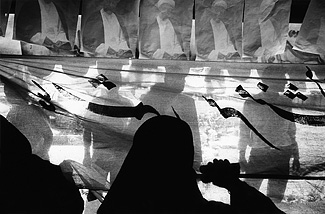
Electionworkers of Haschemi Rafsanjani putting up an election poster in one of his elections centers next to Haft-e-Tir Square in downtown Tehran. Iranian presidental elections june 2005. (Kai Wiedenhöfer)
In the three decades since the revolution, the Islamic Republic—despite its poor image abroad—has taken significant steps toward fulfilling these promises. It has done so by giving priority to social rather than military expenditures, and thus dramatically expanding the Ministries of Education, Health, Agriculture, Labor, Housing, Welfare and Social Security. The military consumed as much as 18 percent of the gross domestic product in the last years of the shah. Now it takes up as little as 4 percent. The Ministry of Industries has also grown in most part because in 1979–1980 the state took over numerous large factories whose owners had absconded abroad. The alternative would have been to close them down and create mass unemployment. Since most of these factories had functioned only because of subsidies from the old regime, the new regime had no choice but to continue subsidizing them.
In three decades the regime has come close to eliminating illiteracy among the post-revolutionary generations, reducing the overall rate from 53 percent to 15 percent.1 The rate among women has fallen from 65 percent to 20 percent. The state has increased the number of students enrolled in primary schools from 4,768,000 to 5,700,000, in secondary schools from 2.1 million to over 7.6 million, in technical schools from 201,000 to 509,000, and in universities from 154,000 to over 1.5 million. The percentage of women in university student populations has gone up from 30 percent to 62 percent. Thanks to medical clinics, life expectancy at birth has increased from 56 to 70, and infant mortality has decreased from 104 to 25 per 1,000. Also thanks to medical clinics, the birth rate has fallen from an all-time high of 3.2 to 2.1, and the fertility rate—the average number of children born to a woman in her lifetime—from 7 to 3. It is expected to fall further to 2 by 2012—in other words, Iran in the near future will achieve near zero population growth.
The Islamic Republic has bridged the chasm between urban and rural life in part by raising the prices of agricultural goods relative to other commodities and in part by introducing schools, medical clinics, roads, electricity and piped water into the countryside. For the first time ever, villagers can afford consumer goods, even motorbikes and pickup trucks. According to one economist who, on the whole, is critical of the regime, 80 percent of rural households own refrigerators, 77 percent televisions and 76 percent gas stoves.2 Some 220,000 peasant families, moreover, have received 850,000 hectares of land confiscated from the old elite. They, together with the some 660,000 families who had obtained land under the earlier White Revolution, form a substantial rural class that has benefited not only from these new social services but also from state-subsidized cooperatives and protective tariff walls. This class provides the regime with a rural social base.
The regime has also tackled problems of the urban poor. It has replaced slums with low-income housing, beautified the worst districts and extended electricity, water and sewage lines to working-class districts. As an American journalist highly critical of the regime’s economic policies admits, “Iran has become a modern country with few visible signs of squalor.”3 What is more, it has supplemented the income of the underclass—both rural and urban—by generously subsidizing bread, fuel, gas, heat, electricity, medicines and public transport. The regime may not have eradicated poverty nor appreciatively narrowed the gap between rich and poor but it has provided the underclass with a safety net. In the words of the same independent-minded economist, “Poverty has declined to an enviable level for middle-income developing countries.”4
In addition to substantially expanding the central ministries, the Islamic Republic has also set up numerous semi-independent institutions, such as the Mostazafin (Oppressed), Martyrs’, Housing, Alavi and Imam Khomeini Relief Foundations. Headed by clerics or other persons appointed by and loyal to the Supreme Leader, these foundations together account for as much as 15 percent of the national economy and control budgets that total as much as half that of the central government. Much of their assets are businesses confiscated from the former elite. The largest of them, the Mostazafin Foundation, administers 140 factories, 120 mines, 470 agribusinesses, 100 construction companies and innumerable rural cooperatives. It also owns the country’s two leading newspapers, Ettelaat and Keyhan. According to the Guardian, in 1993 the foundation employed 65,000 and had an annual budget of over $10 billion.5 Some of these foundations also lobby effectively to protect university quotas for war veterans and together they provide hundreds of thousands with wages and benefits, including pensions, housing and health insurance. In other words, they are small welfare states within the larger welfare state.
The important role the welfare state plays makes these expenditures the third rail of Iranian politics. Few politicians—whether conservative or liberal, reformist or fundamentalist, radical or moderate, pro-business or pro-labor—are foolhardy enough to take advice from Chicago School economists inside and outside the country who denounce the “moral hazards” of big government and instead wax ecstatic over the “virtues” of free markets, privatization, small government, business competition, cost-effectiveness, efficiency, entrepreneurship, globalization and entry into the World Trade Organization. In fact, most politicians since the revolution have subscribed to varying degrees to economic populism. Some, such as former Presidents Ali Akbar Hashemi-Rafsanjani and Mohammad Khatami, were muted populists shy about tampering with social programs. Others, such as President Mahmoud Ahmadinejad, are out-and-out populists promising to “bring the oil money to peoples’ dining room tables” by further expanding social programs. No realist would contemplate drastic cuts in the safety net, though there are limits to the populism: Ahmadinejad, for instance, placed a quota on subsidized gasoline.
Upcoming decades will test the regime’s ability to juggle the competing demands of these populist programs with those of the educated middle class—especially the ever expanding army of university graduates produced, ironically, by one of the revolution’s main achievements. This new stratum needs not only jobs and a decent standard of living but also greater social mobility and access to the outside world—with all its dangers, especially to well-protected home industries—and, concomitantly, the creation of a viable civil society. The regime may be able to meet these formidable demands if it finds fresh sources of oil and gas revenues—but to do so it will need to markedly improve its relations with Washington so that economic sanctions can be lifted. Without the lifting of sanctions, Iran cannot gain access to the technology and capital needed to develop its large gas reserves. If new revenues do not materialize, class politics will threaten to rear its head again. For 30 years, populism has managed to blunt the sharp edge of class politics. It may not do so in the future.
Notes:
[1] Most of these statistics have been taken from government reports. For updated summaries of these reports, see Middle East Institute, The Iranian Revolution at 30 (Washington, DC, 2009).
[2] Djavad Salehi-Isfahani, “Poverty and Inequality Since the Revolution,” The Iranian Revolution at 30 (Washington, DC: Middle East Institute, 2009), p. 107.
[3] Laura Secor, “The Rationalist,” New Yorker, February 2, 2009.
[4] Salehi-Isfahani, p. 105.
[5] Guardian, July 9, 1993.
About the Author:
Ervand Abrahamian is a historian of Middle Eastern and particularly Iranian history. An Armenian born in Iran and raised in England, he received his M.A. at Oxford University and his Ph.D. at Columbia University. He teaches at the City University of New York (CUNY) where he is Distinguished Professor of History at Baruch College and the CUNY Graduate Center. He has taught at Princeton University, New York University and Oxford University. He is currently working on a book about the 1953 Iranian coup d’état for Cambridge University Press. His other publications are: Iran Between Two Revolutions (1982), The Iranian Mojahedin (1989), Khomeinism (1993), Tortured Confessions (1999), Inventing the Axis of Evil and A History of Modern Iran (2008).



 RSS
RSS


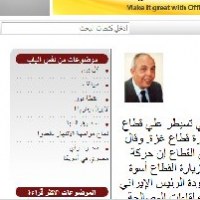
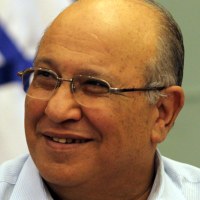
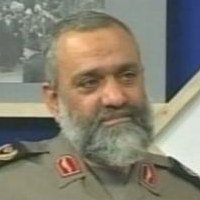
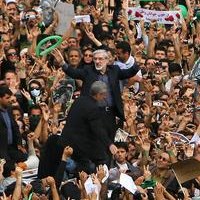





Why the Islamic Republic of Iran Survived #iran http://j.mp/cyps4u
RT @CrethiPlethi: Why the Islamic Republic of Iran Survived #iran http://j.mp/cyps4u
[…] Why the Islamic Republic of Iran has Survived | Middle East Affairs Information Center | Analysis, D… […]
[…] Ash's coinage refolution … His point, as Carl Boggs argues in The Two Revolutions, was that …Why the Islamic Republic of Iran has Survived | Middle East …Middle East Affairs Information Center | Analysis and In depth information on Middle East Affairs, […]